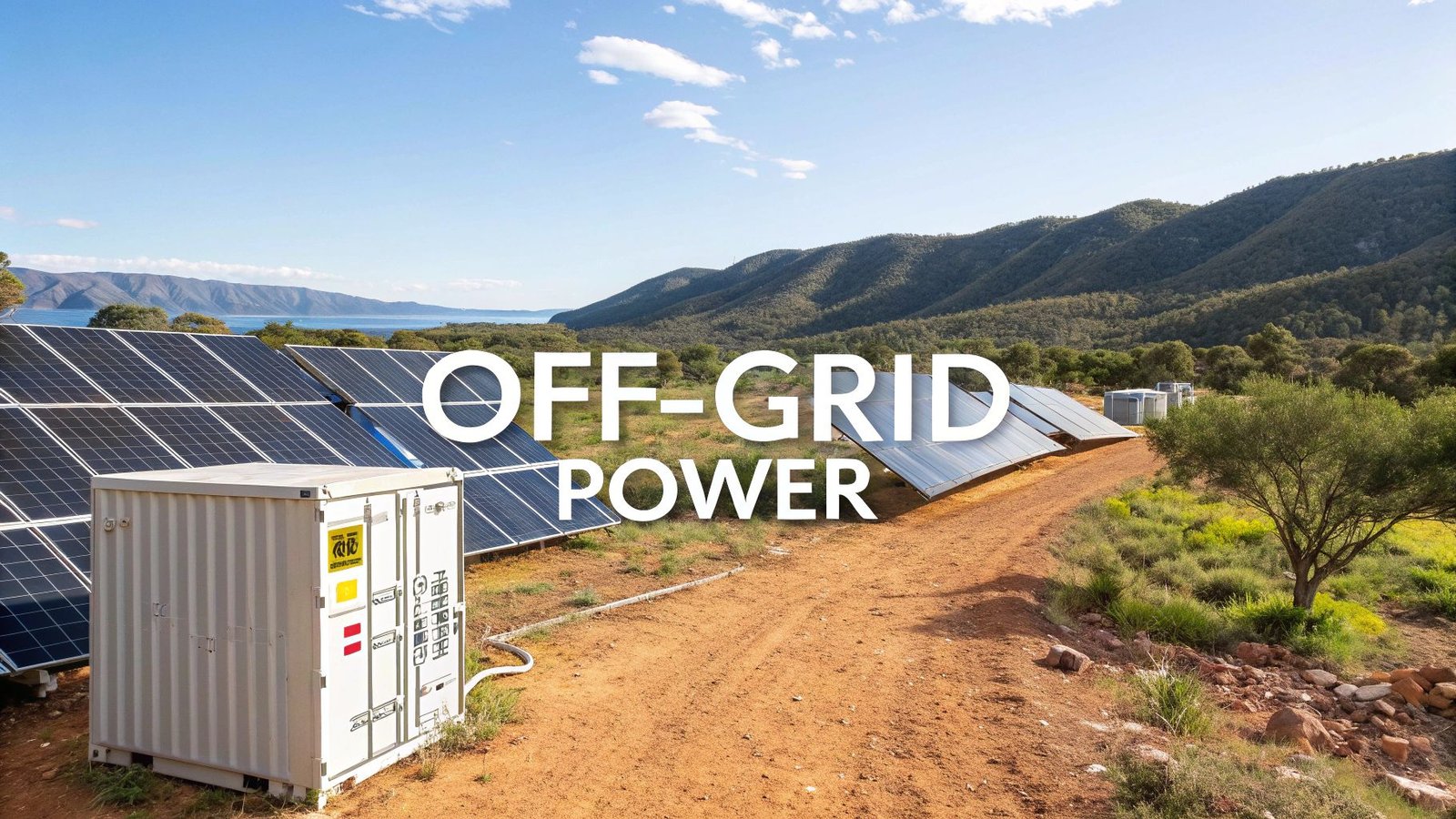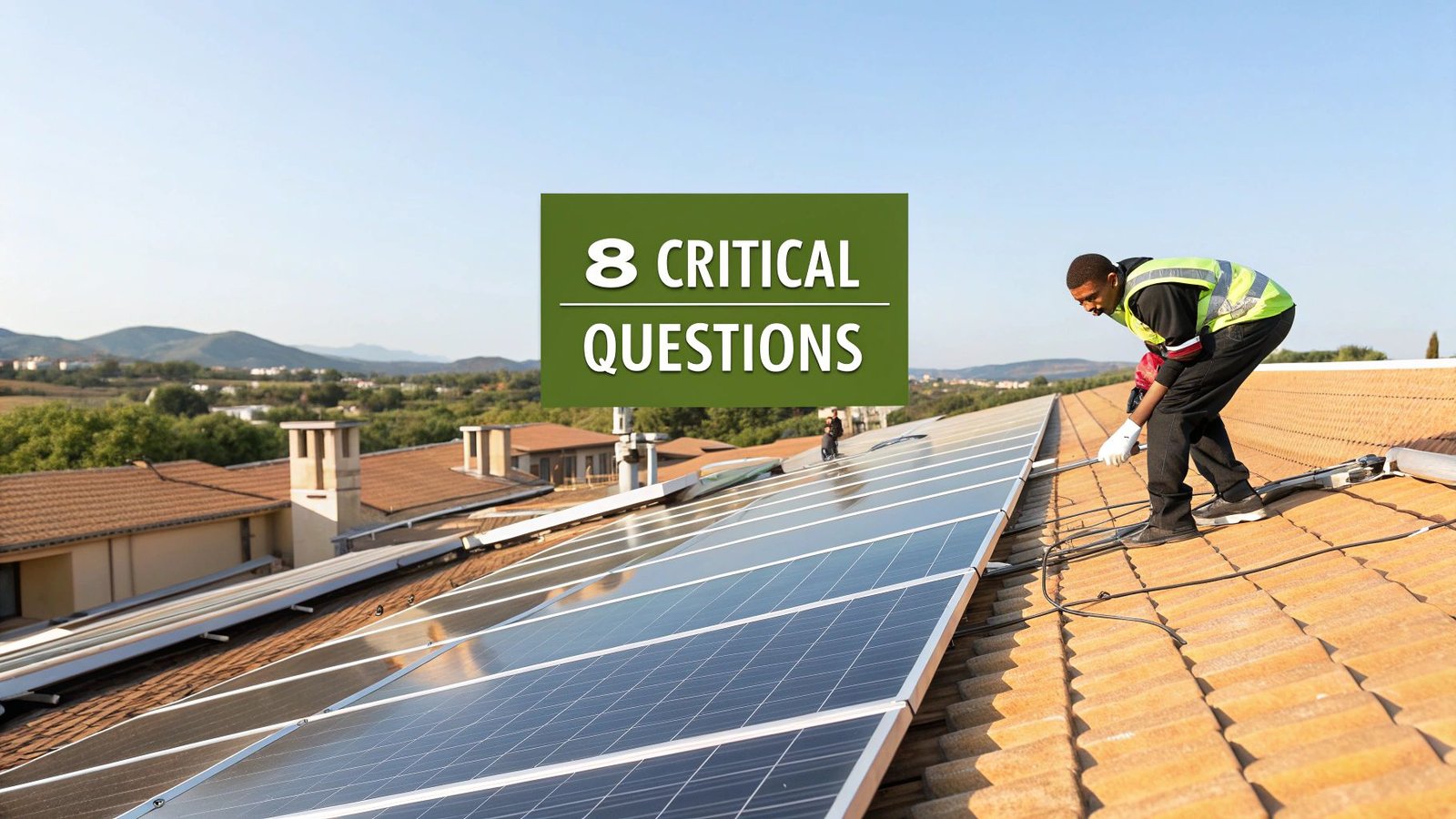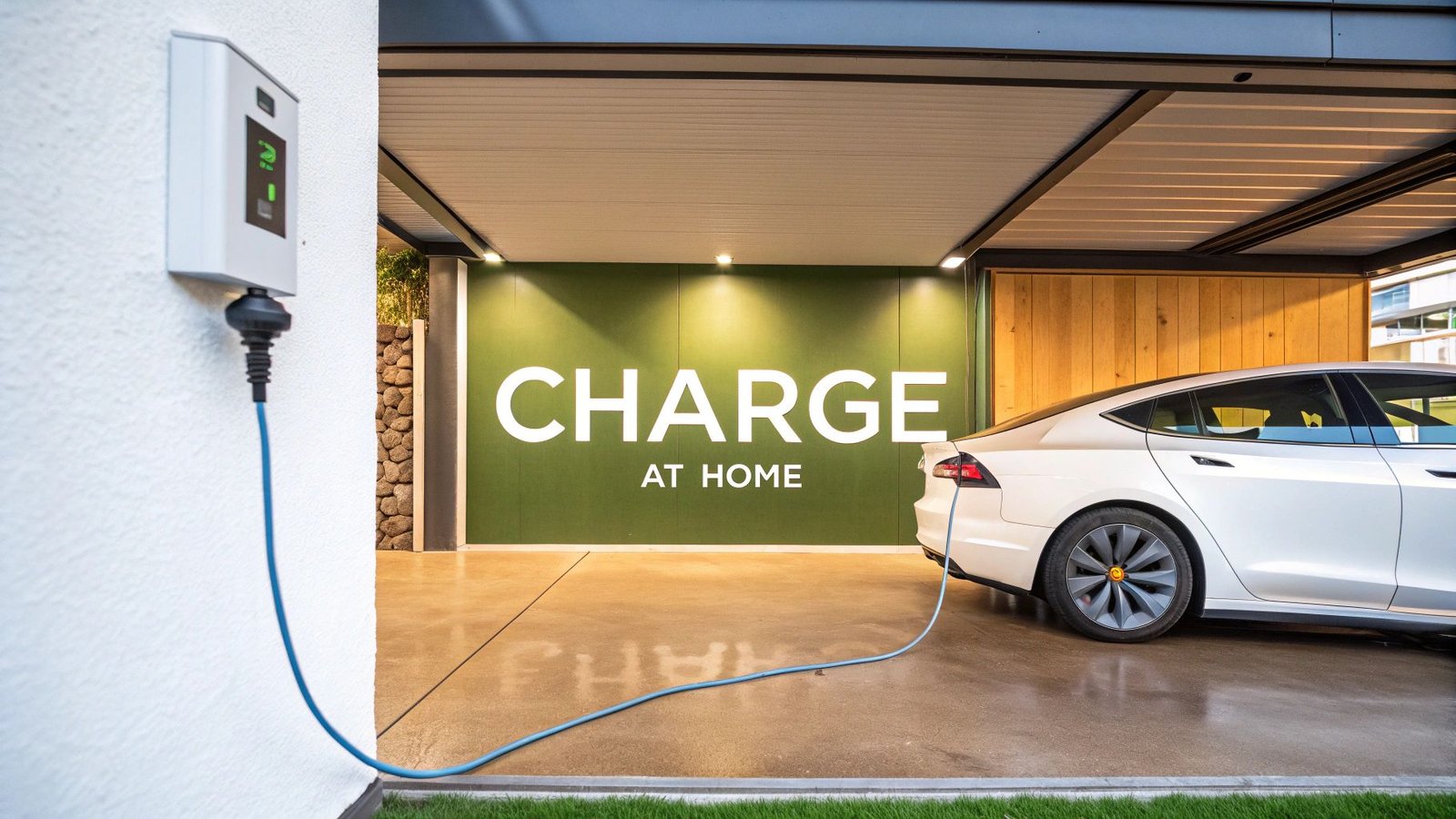If you’re looking for the best batteries for off-grid living, I’ll cut to the chase: Fosfato de litio y hierro (LiFePO4) is the answer for most people. These batteries simply deliver the best mix of long life, high efficiency, and safety, which ultimately leads to a lower total cost over time. While the old-school Lead-Acid batteries can still work on a tight budget, you'll be making some serious compromises on performance.
Choosing Your Off-Grid Powerhouse
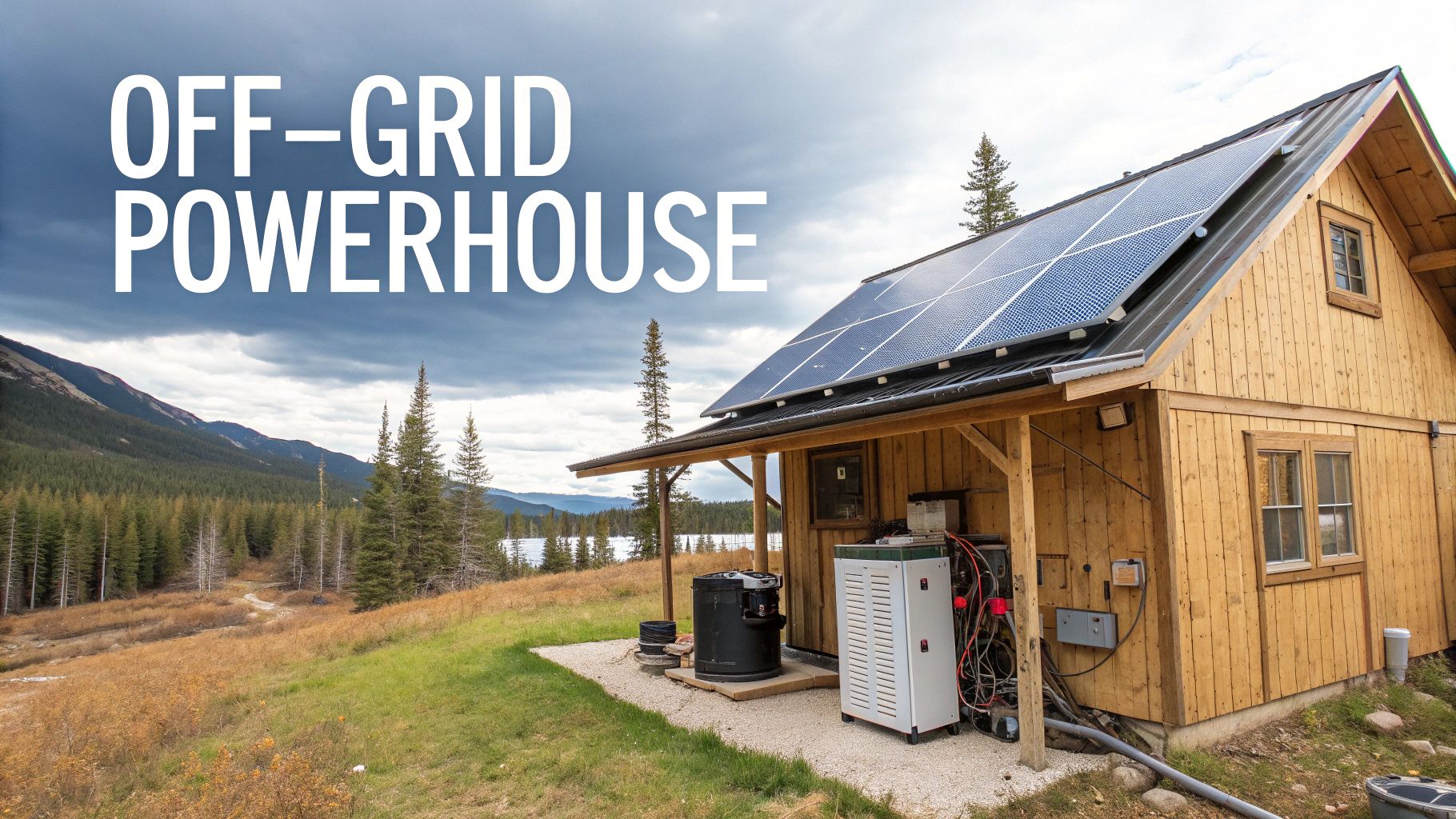
Picking the right battery for your off-grid solar setup is hands-down the most important decision you'll make. This isn't just about buying a power source; it's the heart of your energy independence. Your choice will directly impact the system's day-to-day reliability, how it performs, and whether it makes financial sense in the long run. The battery is what determines how much energy you can actually store and use when the sun isn't shining.
It's a decision that's only getting more crucial. The global market for off-grid energy storage was already valued at $962 million in 2021 and is on track to nearly double to $1.87 billion by 2025. This boom is all about more people embracing renewables and the incredible leaps we've seen in battery technology.
Understanding Core Battery Metrics
Before we can really compare battery chemistries, we need to speak the same language. Getting a handle on these key metrics is the first step toward making a smart investment, especially if you’re just starting to explore off-grid solar power solutions.
To help you get up to speed, here’s a quick rundown of the essential terms you'll see when evaluating any battery. Think of this as your cheat sheet.
Quick Guide to Key Off-Grid Battery Metrics
| Métrica | What It Means for Your System | Why It Matters for Off-Grid |
|---|---|---|
| Capacity (kWh) | This is the total energy your battery can hold. For example, a 10kWh battery can supply 1 kilowatt of power continuously for 10 hours. | It dictates how long your lights stay on without sun. More capacity means more energy security during long cloudy spells. |
| Profundidad de descarga (DoD) | The percentage of the battery's total capacity you can safely use without damaging it. | A higher DoD means you get to use more of the energy you paid to store. This is crucial for maximizing your usable capacity. |
| Cycle Life | The number of times a battery can be fully charged and discharged before it starts to lose a significant amount of its original capacity. | This is the best indicator of how long your battery will last. More cycles mean a longer lifespan and a better return on your investment. |
These terms aren't just technical jargon; they are the fundamental stats that define a battery's real-world performance and value.
Lo más importante: Your battery isn't just another part of the system—it’s the anchor. If you get these core concepts wrong, you risk designing a system that’s too small, facing premature battery failure, and dealing with a lot of unexpected costs.
To build a solid foundation, I'd recommend digging into a comprehensive guide on battery and charging technologies before making a final decision.
Lithium-Ion: The Modern Standard
Any serious discussion about the best batteries for off-grid systems today quickly lands on lithium-ion. It's become the go-to standard, and for good reason—it has completely changed how we think about energy independence. This isn't just hype; it's a real shift driven by performance advantages that make a massive difference for anyone living off-grid.
Lithium-ion batteries now dominate the off-grid battery energy storage systems (BESS) market. They're prized for packing more power into less space, lasting far longer, and coming down in price. In fact, the global market for these systems is growing at a compound annual rate of over 20%, a clear sign of how effective they are. Insight Ace Analytic projects this market will hit a staggering $326.9 billion valuation.
Unlike the old lead-acid world where one size fit all, "lithium-ion" is actually a family of different chemistries. For a home off the grid, two main types come into play: Lithium Iron Phosphate (LiFePO4) and Lithium Nickel Manganese Cobalt Oxide (NMC). While you’ll find NMC in most electric vehicles because of its high energy density, LiFePO4 is the undisputed champion for home energy storage.
Why LiFePO4 Is The Clear Winner
The biggest reason LiFePO4 is the right choice for an off-grid home comes down to safety and stability. Its internal chemistry is incredibly resistant to thermal runaway—a dangerous condition where a battery overheats uncontrollably. This inherent stability means you can install a large battery bank in your home with complete peace of mind.
Beyond being safer, LiFePO4 batteries offer a lifespan that older technologies just can't touch. A quality LiFePO4 battery will give you thousands of charge cycles, easily lasting more than a decade even with daily use. This longevity shifts the battery from being a consumable part you have to replace every few years to a long-term investment in your home's infrastructure.
La opinión de los expertos: When you choose LiFePO4, you're really choosing long-term reliability. Its stable chemistry doesn't just prevent safety issues; it also delivers consistent performance across a wider range of temperatures—a critical factor for off-grid homes in climates that see real heat and cold.
This incredible cycle life is paired with a very high depth of discharge (DoD). You can regularly use 90-100% of a LiFePO4 battery's stated capacity without harming it. That means a 10 kWh LiFePO4 battery gives you nearly twice the usable energy as a 10 kWh lead-acid battery, which can only be safely discharged to 50%.
Real-World Performance and Efficiency
The benefits of LiFePO4 really shine when you look at how it performs day in and day out. One of the most important metrics is its round-trip efficiency, which is typically over 95%. In simple terms, for every 100 watts of solar power you push into the battery, you get more than 95 watts back out.
This high efficiency has a real impact. Your battery bank charges faster from your solar panels, and you waste far less of the precious energy you generate. The difference between LiFePO4 and traditional lead-acid batteries is stark.
Round-Trip Efficiency Comparison
graph TD
subgraph LiFePO4
A[100W In] -->|Round-Trip Loss: <5%| B(95W+ Out)
end
subgraph Lead-Acid
C[100W In] -->|Round-Trip Loss: 15-20%| D(80-85W Out)
end
style A fill:#90ee90,stroke:#333,stroke-width:2px
style B fill:#90ee90,stroke:#333,stroke-width:2px
style C fill:#ffcccb,stroke:#333,stroke-width:2px
style D fill:#ffcccb,stroke:#333,stroke-width:2px
That efficiency gap means a LiFePO4 system doesn't need as large of a solar array to compensate for energy losses, which can save you a good chunk of money on panels right from the start.
On top of that, these batteries are practically maintenance-free. Forget about checking water levels, cleaning corroded terminals, or running special "equalization" charges. An integrated Battery Management System (BMS) does all the work, balancing the cells and protecting them from overcharging or draining too low. It ensures both safety and a long lifespan with zero effort on your part.
Yes, the upfront cost for LiFePO4 is higher. But when you factor in its dramatically longer lifespan, greater usable capacity, and superior efficiency, the total cost of ownership is significantly lower. If you break it down by the cost per kWh you get out of the battery over its entire life, LiFePO4 is, without a doubt, the smartest financial choice for any serious off-grid setup.
Evaluating Lead-Acid: The Tried-and-True Option
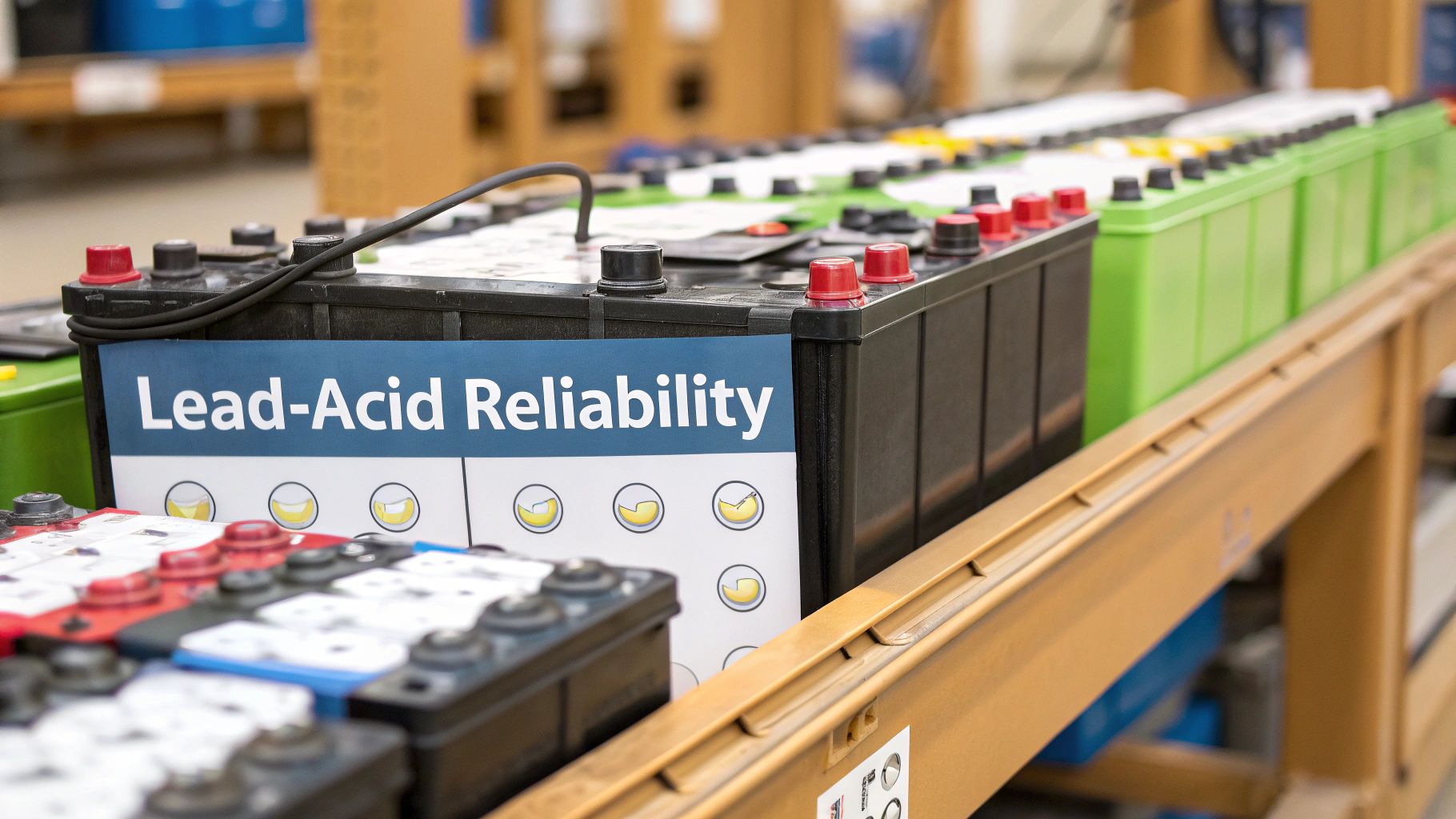
While lithium batteries get most of the attention these days, lead-acid technology is still very much in the game for off-grid living. For decades, these were the workhorses of solar storage, and they've earned a reputation for being dependable and, most importantly, affordable.
Their low upfront cost is often the biggest draw, making them a practical entry point for those on a tight budget or with modest power demands. But choosing lead-acid isn't just about saving money at the start; it's about understanding the compromises you're making down the road. It’s also not one-size-fits-all, as the "lead-acid" category has a couple of important variations.
Flooded vs. Sealed Lead-Acid Batteries
The first major split you'll encounter is between Flooded Lead-Acid (FLA) y Sealed Lead-Acid (SLA) batteries. FLAs are the classic, old-school choice and the most affordable option you'll find. The catch? They require regular maintenance. You’ll be popping caps, checking electrolyte levels, and topping them off with distilled water—a hands-on commitment that isn't for everyone.
SLA batteries, which include Absorbent Glass Mat (AGM) y Gel types, were designed to solve that problem. They are completely sealed, which means no watering, no fumes, and no risk of acid spills. This convenience costs a bit more, but it’s a trade-off many are happy to make for peace of mind.
- Flooded Lead-Acid (FLA): The champion of low initial cost, but it demands routine upkeep, proper ventilation to handle gassing, and careful handling.
- Sealed Lead-Acid (SLA – AGM/Gel): Pricier than FLA but offers a maintenance-free, "set-it-and-forget-it" design. This makes it a safer and simpler choice, especially for indoor installations or remote sites.
The Critical 50% Depth of Discharge Rule
Here’s the single most important thing to understand about lead-acid batteries: their Profundidad de descarga (DoD) limitation. To get a decent lifespan out of them, you can really only use about 50% of their rated capacity. If you regularly drain them further than that, you will dramatically shorten their life.
This has massive practical implications. It means you have to buy twice the storage capacity you actually need. If your home uses 5 kWh of energy overnight, you must install a 10 kWh lead-acid battery bank. This doubles the physical footprint, the weight, and, over the long haul, the cost of your system relative to the energy you can actually use.
Crucial Insight: The 50% DoD rule isn't just a friendly suggestion; it's a hard limit for getting your money's worth. Ignore it, and you could be replacing your entire battery bank in just a couple of years instead of the expected five to seven.
When you visualize this, the difference is stark.
Usable Energy from a 10 kWh Battery Bank
pie
title LiFePO4 (90% DoD)
"Usable Energy (9.0 kWh)" : 90
"Reserved" : 10
pie
title Lead-Acid (50% DoD)
"Usable Energy (5.0 kWh)" : 50
"Reserved" : 50
Performance Trade-Offs and Ideal Scenarios
On top of the DoD limitation, lead-acid batteries are just less efficient. Their round-trip efficiency is typically around 80-85%. In simple terms, for every 100 watts of solar power you push into the battery, you only get about 80-85 watts back out. That lost 15-20% adds up over time, often meaning you need a slightly larger solar array to make up for the energy lost in storage.
So, with these drawbacks, when does lead-acid actually make sense?
- When the Budget is Everything: If upfront cost is the number one barrier, FLA batteries still offer the cheapest way to get into energy storage.
- For Infrequent Use: Think of a seasonal cabin, a weekend hunting camp, or a backup power system that only kicks on a few times a year. In these cases, the shorter lifespan and lower performance are far less of a problem.
- For the Hands-On DIYer: If you enjoy tinkering and don't mind the regular maintenance schedule of FLA batteries, you can save a significant amount of money upfront.
Ultimately, going with lead-acid is a deliberate choice. You're trading long-term performance, higher efficiency, and convenience for immediate, real-world savings.
Comparing Off-Grid Battery Technologies
When it comes to picking the best batteries for an off-grid system, the conversation almost always boils down to two main players: modern Lithium Iron Phosphate (LiFePO4) and the old standby, Lead-Acid. We've touched on their individual characteristics, but now it's time for a head-to-head comparison focused on what really matters for your system’s performance and your wallet over the long haul.
We're going to move past simple pro/con lists and dig into how the technical differences in efficiency, lifespan, and usable capacity actually play out in the real world. This is about seeing beyond the initial price tag to understand the true value each technology brings to the table over its entire life.
Cycle Life and Lifetime Cost
The single biggest difference you'll find is how long a battery will last, which we measure in "cycle life." A modern LiFePO4 battery is built to handle 3,000 to 5,000+ full charge-and-discharge cycles and still hold most of its original capacity. In sharp contrast, a high-quality lead-acid battery will give you somewhere between 500 to 1,000 cycles, and that’s if you treat it perfectly.
This massive gap in longevity completely changes the total cost of ownership. Sure, lead-acid looks cheaper upfront, but you’ll likely find yourself replacing the entire battery bank three, four, or even five times before a single LiFePO4 bank is ready for retirement. When you look at it over a 10-15 year timeframe, lithium is almost always the more economical choice.
Información clave: Don't mistake the sticker price for the long-term cost. A much smarter metric is the lifetime cost per kilowatt-hour (kWh) you can actually store and use. For LiFePO4, this number is often dramatically lower simply because it lasts so much longer.
This infographic breaks down the key performance and cost differences between LiFePO4 and a typical Lead-Acid battery.
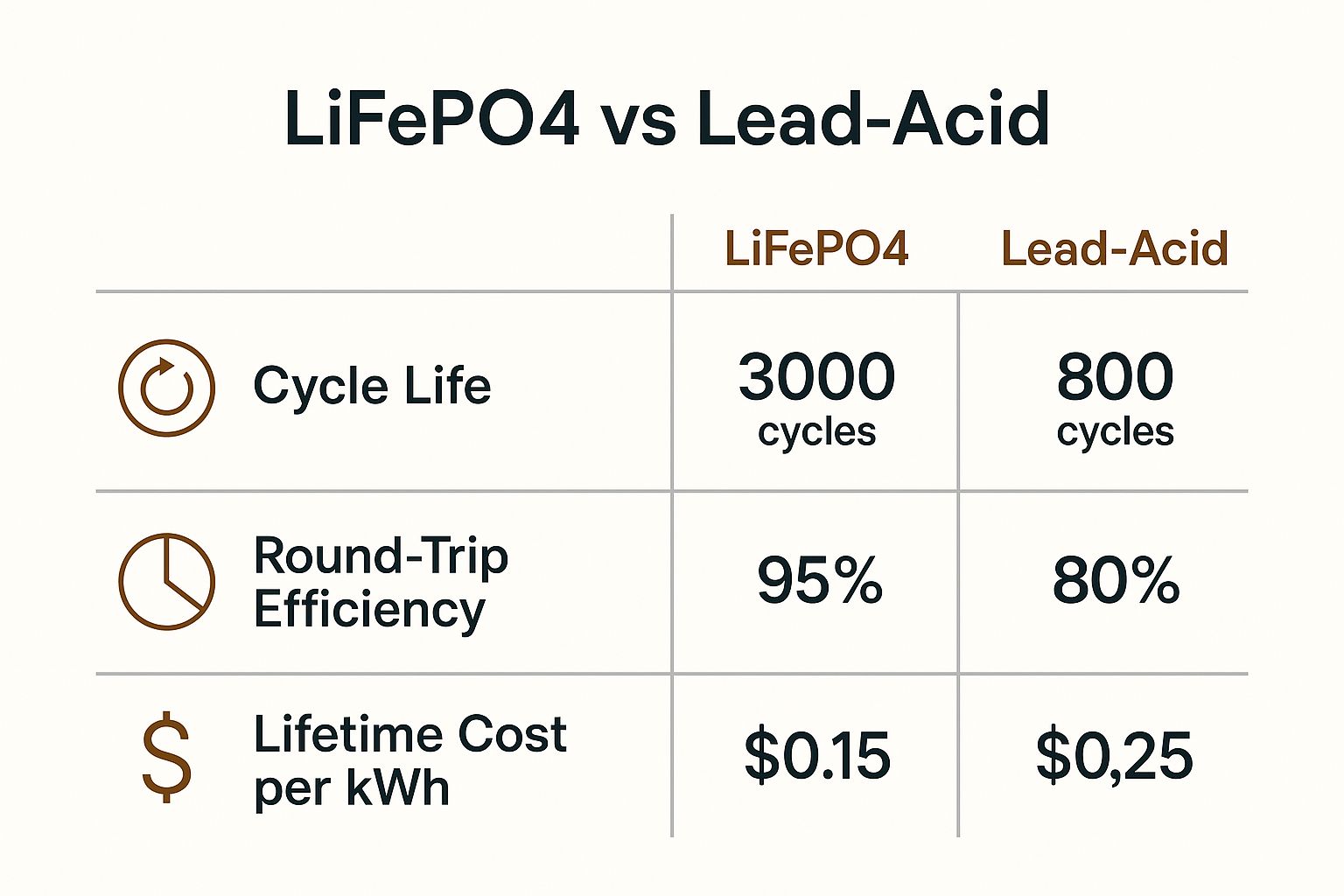
The numbers make it clear: LiFePO4 delivers far superior performance and a lower total cost over time, making it the better investment for any serious off-grid setup.
Round-Trip Efficiency and Wasted Energy
Another absolutely critical metric is eficacia de ida y vuelta. This tells you how much energy you get back out for every unit of energy you put in. LiFePO4 batteries are incredibly efficient, boasting a rating of 95% or higher. That means if you put 100 kWh of solar energy into your battery, you get to use at least 95 kWh of it.
Lead-acid batteries just aren't in the same league, typically hovering around 80-85% efficiency. That 10-15% difference is energy that literally disappears as waste heat every time you charge and discharge.
This efficiency gap has a couple of big consequences. First, it means a system using lead-acid batteries needs a bigger, more expensive solar array just to make up for the energy being lost in storage. Second, it makes the batteries charge slower—a real headache on cloudy days when every ray of sun counts. For a closer look at the science behind this, our guide on how to store solar energy provides more detail.
Usable Capacity and Depth of Discharge
The final piece of this puzzle is usable capacity, which is determined by the battery’s recommended Profundidad de descarga (DoD). As we've mentioned, to avoid damaging them and shortening their already limited lifespan, lead-acid batteries should only be discharged to about 50% of their rated capacity.
LiFePO4 batteries, on the other hand, don't have this limitation; you can safely and regularly discharge them to 90-100% of their capacity. So, a 10 kWh LiFePO4 battery actually gives you at least 9 kWh of usable power. To get that same 9 kWh from lead-acid, you'd need to install a massive 18 kWh bank.
This directly impacts the physical size, weight, and complexity of your system. A lithium-based setup is much smaller, lighter, and requires fewer batteries and cables, which simplifies the installation and leaves fewer potential points of failure.
For a quick summary of how these technologies stack up, the table below compares them across the most important factors for anyone building an off-grid power system.
Lithium-Ion vs Lead-Acid A Detailed Off-Grid Comparison
| Característica | Lithium-Ion (LiFePO4) | Sealed Lead-Acid (AGM) | Flooded Lead-Acid (FLA) |
|---|---|---|---|
| Typical Cycle Life | 3,000 – 5,000+ cycles | 400 – 1,000 cycles | 500 – 1,200 cycles |
| Usable Capacity (DoD) | 90% – 100% | 50% | 50% |
| Eficiencia de ida y vuelta | 95%+ | 80% – 85% | 75% – 80% |
| Maintenance | None (BMS handles everything) | Ninguno | Regular watering & equalization |
| Lifetime Value | Excellent (lower cost per kWh) | Fair (frequent replacements) | Good (lowest initial cost) |
How to Size Your Off-Grid Battery Bank
Figuring out which batteries to buy is a huge step, but it's only part of the puzzle. Sizing your battery bank correctly is just as important. If you go too small, you'll be left in the dark when you need power most. Go too big, and you've just wasted a serious amount of money. The real goal here is to find that sweet spot—total energy security without breaking the bank.
This isn't a time for guessing. Getting this right comes down to a methodical process of understanding exactly what your lifestyle demands. Follow these steps, and you'll build a system that keeps the lights on, rain or shine.
Step 1: Run the Numbers with an Energy Audit
Everything starts with an energy audit. This is simply the process of adding up the daily electricity needs of every single appliance you plan to run off-grid. Get a notepad or a spreadsheet and list everything out, from the big stuff like your refrigerator and well pump down to your lights and laptop charger.
For each device, you need to find two things: how many watts it consumes and how many hours you use it each day. Multiply those two numbers together, and you get its daily energy usage in watt-hours (Wh).
Let's look at a simple example for a small off-grid cabin:
| Appliance | Power (Watts) | Hours/Day | Daily Use (Wh) |
|---|---|---|---|
| LED Lights (4) | 40 W | 5 hours | 200 Wh |
| Refrigerator | 150 W | 8 hours | 1200 Wh |
| Laptop Charger | 65 W | 4 hours | 260 Wh |
| Total Daily Use | 1,660 Wh or 1.66 kWh |
Once you’ve tallied everything up, add the watt-hours together for a grand total. This number is your daily energy target, the foundation for all the other calculations.
Step 2: Plan for Cloudy Days with Autonomy
What happens when a storm rolls in and your panels aren't producing much? That’s where "days of autonomy" comes in. This is the number of consecutive sunless days your battery bank can carry you through on a full charge. It's the ultimate safety net for any serious off-grid system.
For a full-time home, especially in a region with unpredictable weather, aiming for three to five days of autonomy is a smart move. If you're just building a weekend getaway cabin, you can probably get by with one or two days.
Crucial Insight: One of the most common and costly mistakes I see is people skimping on autonomy. Running out of power after a single cloudy day isn't just an inconvenience; it can damage your batteries and completely disrupt your life.
The math here is straightforward: just multiply your daily energy consumption by the number of autonomy days you want.
- Calculation:
Daily Energy Use (Wh) x Days of Autonomy = Total Storage Needed (Wh)
Step 3: Adjust for Battery Chemistry and Voltage
The final piece of the puzzle is to tailor your calculation to the specific battery chemistry you've chosen. As we've covered, lead-acid and lithium batteries have vastly different rules about how deeply you can discharge them (Depth of Discharge or DoD), which directly impacts the total bank size you'll need to buy.
-
Factor in Depth of Discharge (DoD): Take the total storage you need (from Step 2) and divide it by the battery's recommended DoD. For LiFePO4, use 0.9 (90%); for lead-acid, you have to use 0.5 (50%). This calculation gives you the actual total capacity you need to shop for.
-
Convert to Amp-Hours (Ah): To get the final number, divide that total capacity by your system voltage (12V, 24V, or 48V are common). This gives you the size in amp-hours (Ah), which is how most batteries are sold. If you want to double-check your numbers, a good solar system sizing calculator can help confirm your math.
Let’s apply this to our cabin example (1,660 Wh/day) with 3 days of autonomy on a 24V system:
- LiFePO4 System:
(1,660 x 3) / 0.9 DoD = 5,533 Wh. Then,5,533 Wh / 24V = **231 Ah** - Lead-Acid System:
(1,660 x 3) / 0.5 DoD = 9,960 Wh. Then,9,960 Wh / 24V = **415 Ah**
The difference is stark. Because you can only use half of a lead-acid battery's capacity, you're forced to buy a much larger, heavier, and more expensive bank to get the exact same amount of usable energy as you would from lithium.
Making the Right Choice for Your System
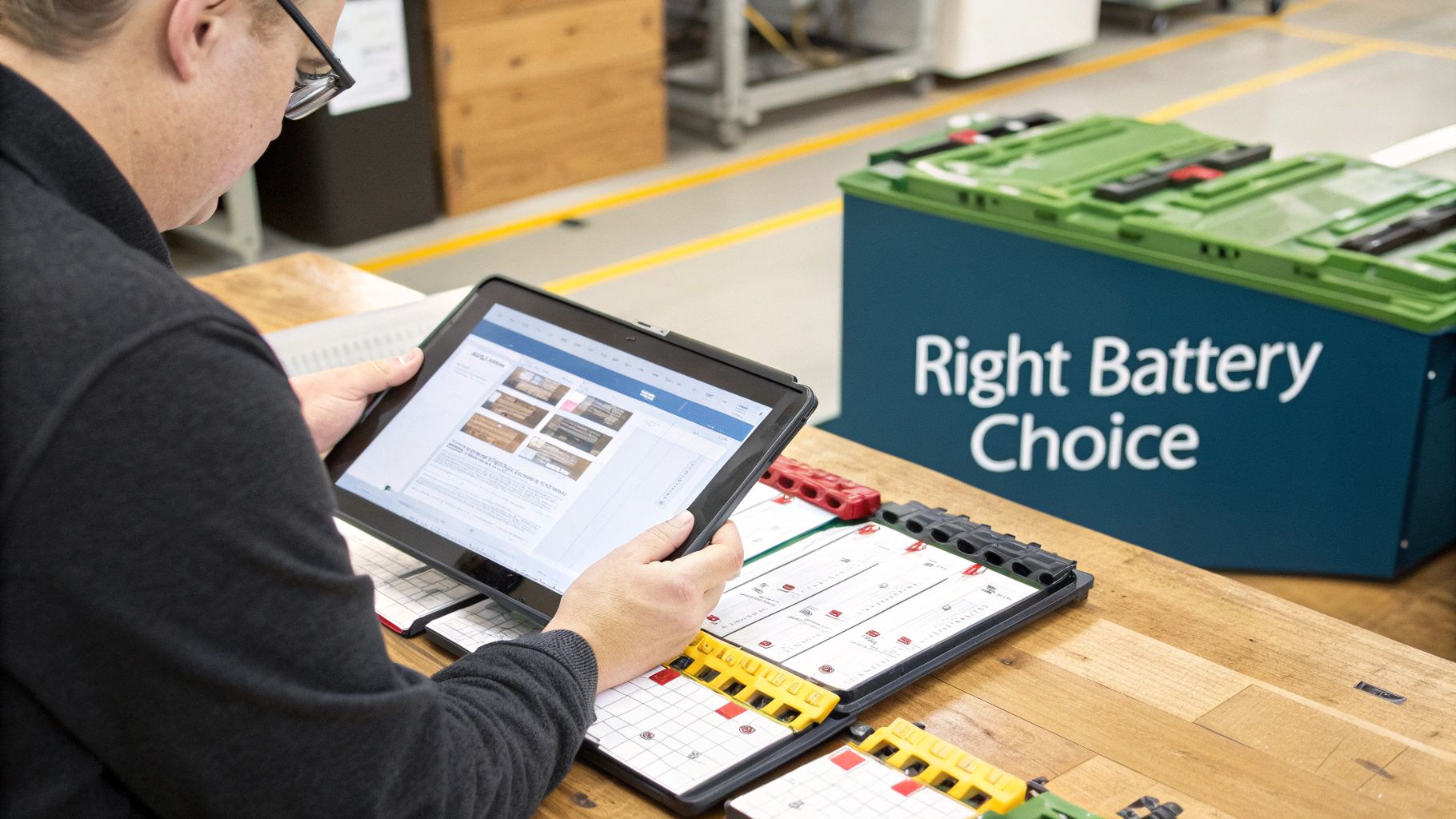
We've covered a lot of ground—from the deep-dive on technology to sizing your bank. Now, let’s bring it all home. Choosing the best batteries for off grid life isn't about picking a winner from a catalog. It’s about finding the perfect match for your lifestyle, your budget, and what you expect from your power system.
At the end of the day, your specific situation dictates the right answer. To make this crystal clear, let's look at two of the most common off-grid scenarios and see how the decision process plays out.
Tailoring Your Battery to Your Lifestyle
If you're living off-grid full-time, your battery bank is the heart of your home. Performance, reliability, and lifespan are non-negotiable. For this kind of setup, Fosfato de litio y hierro (LiFePO4) is really the only way to go. Yes, the initial cost is higher, but that investment buys you peace of mind with a much longer lifespan, better efficiency, and zero maintenance. It delivers true energy security and a lower overall cost in the long run.
But what if you just have a seasonal cabin or a weekend hunting camp? The math looks a little different. For intermittent use with more modest power needs, an AGM Lead-Acid battery starts to make a lot of sense. The low barrier to entry makes your project more affordable, and you won't feel the sting of its shorter lifespan since you're not cycling it every single day.
This simple table can help guide your thinking based on what's most important to you.
Decision Matrix: Your Off-Grid Battery Profile
| Your Primary Priority | Full-Time Residence (High Use) | Seasonal Cabin (Low Use) |
|---|---|---|
| Long-Term Value & Performance | LiFePO4 (Recommended) | LiFePO4 (Good Choice) |
| Lowest Upfront Cost | Lead-Acid (Compromise) | AGM Lead-Acid (Recommended) |
| Minimal Maintenance | LiFePO4 (Recommended) | LiFePO4 (Good Choice) |
Final Word of Advice: Think of your battery bank as a decade-long investment, because it is. If you prioritize long-term value over short-term savings now, you'll almost always end up with a more reliable and cost-effective system down the road.
Final System Integration Checks
Before you pull the trigger, do one last check. Make sure the battery you’ve picked plays well with your other gear, especially your solar charge controller and inverter. You don't want to create a bottleneck or, worse, damage your brand-new batteries because of an equipment mismatch.
Keep in mind, battery technology is always moving forward. The economics and performance are constantly improving. To give you some perspective, batteries now provide 84% of grid regulation services in some areas, highlighting just how essential they've become for energy stability.
And remember, your power system is just one piece of the puzzle. Being truly self-sufficient means thinking about connectivity, too. Once your lights are on, you’ll want to explore the different off-grid internet options to stay connected.
Common Questions About Off-Grid Batteries
When you're planning an off-grid system, the battery bank is often where the most questions pop up. Let's tackle some of the most common ones we hear from folks designing their own power systems.
Can I Mix Old and New Batteries in My Bank?
It’s a tempting idea, especially if you're looking to save a few bucks, but you really shouldn't. Mixing old and new batteries—or even batteries with different capacities—creates a serious imbalance. The weaker, older batteries will constantly drag down the newer, stronger ones, which tanks your system's overall efficiency and drastically shortens the lifespan of the entire bank.
For the best performance and longevity, always build your bank with identical battery models bought at the same time. It's the only way to ensure they work together as a cohesive unit.
Are Lithium Batteries Safe for a Home System?
Absolutely, as long as you're using the right kind. Modern Fosfato de litio y hierro (LiFePO4) batteries are incredibly safe for residential use. Their chemistry is far more stable than other lithium-ion types, so you don't have to worry about the thermal runaway issues that have made headlines.
Key to safety: Always buy from a well-known brand and make sure your system has a proper Battery Management System (BMS). A good BMS is your battery's bodyguard, protecting it from overcharging, deep discharging, and unsafe temperatures.
How Does Cold Weather Affect My Batteries?
Cold weather is the enemy of all batteries, but each type reacts differently. Lead-acid batteries will see their usable capacity drop significantly as the temperature falls.
Lithium batteries have a much stricter rule: they should not be charged below freezing (0°C or 32°F). Doing so can cause permanent damage. Some premium models come with built-in heaters to solve this, but if yours don't, you have to protect them. If you live in a cold climate, plan on installing your battery bank in an insulated, conditioned space to protect your investment.
What Is a Battery Management System?
Think of the Battery Management System (BMS) as the brain of your lithium battery pack. It's a non-negotiable component that constantly monitors the health of the battery, protects the cells from damage, and ensures everything stays balanced for a long, healthy life.
It prevents dangerous conditions like over-voltage or under-voltage. Any quality battery designed for off-grid use will have a robust BMS built right in.
Ready to build an off-grid system with the right energy storage? The experts at Energía radiante can help you choose and size the perfect battery bank for your needs. Explore our high-performance solar solutions at https://radiantenergysolar.com.

